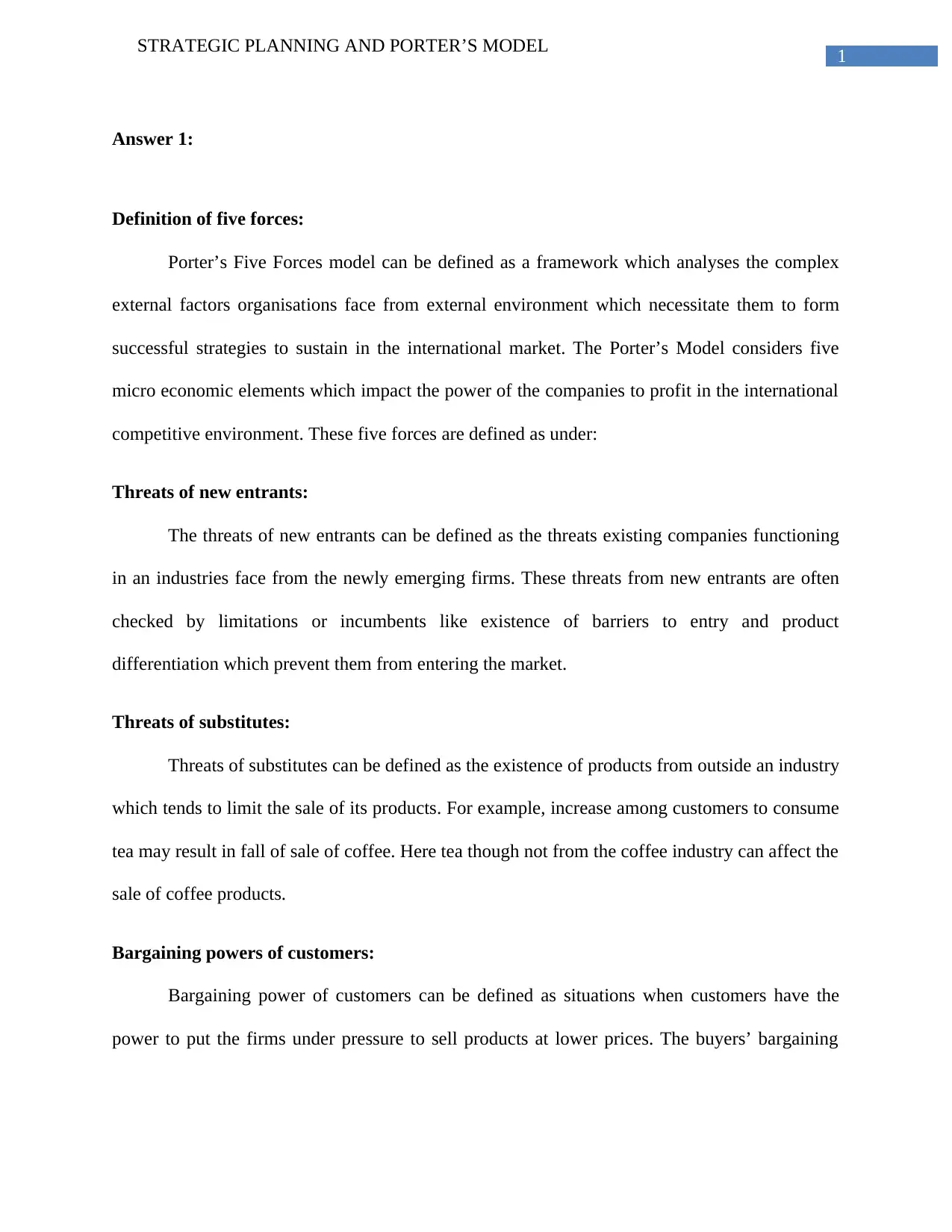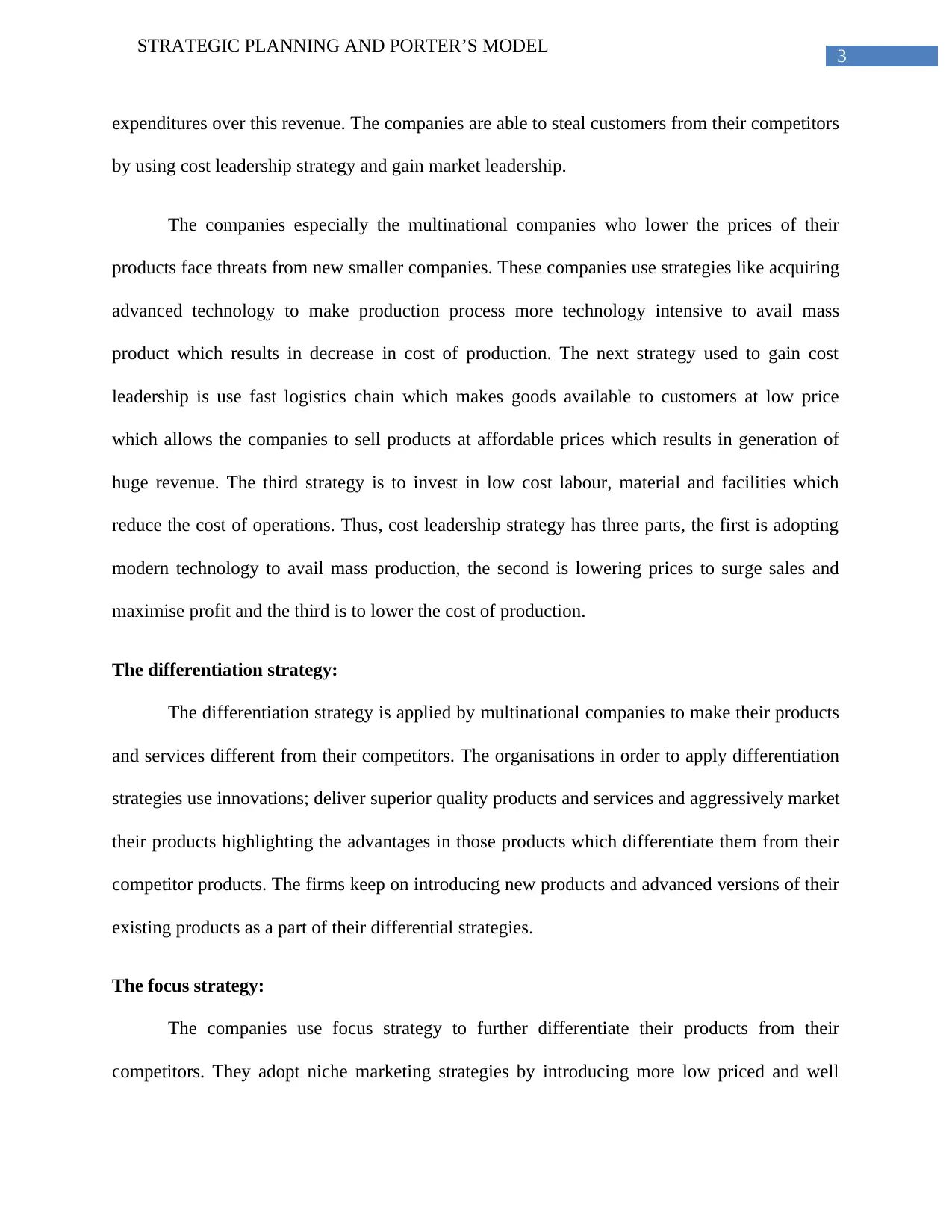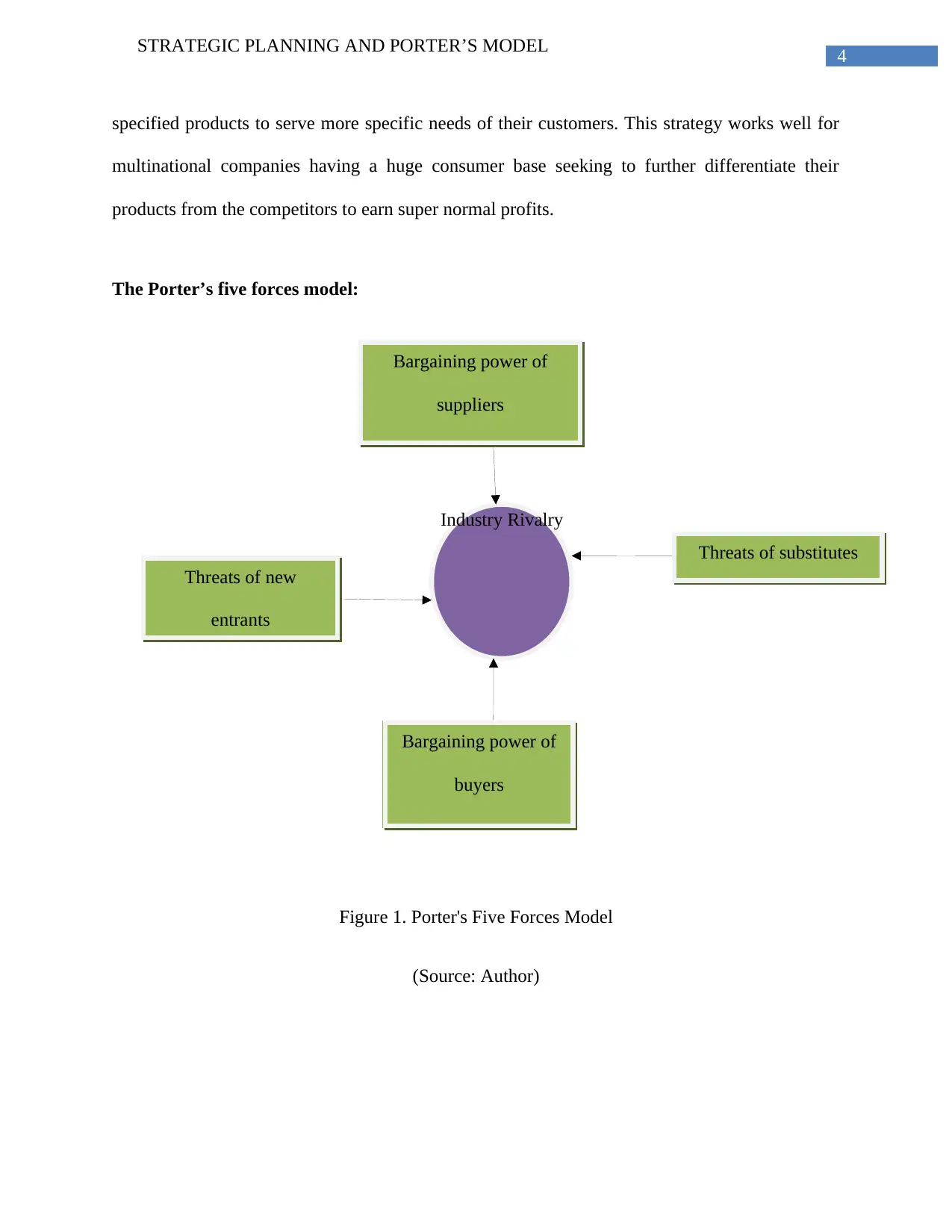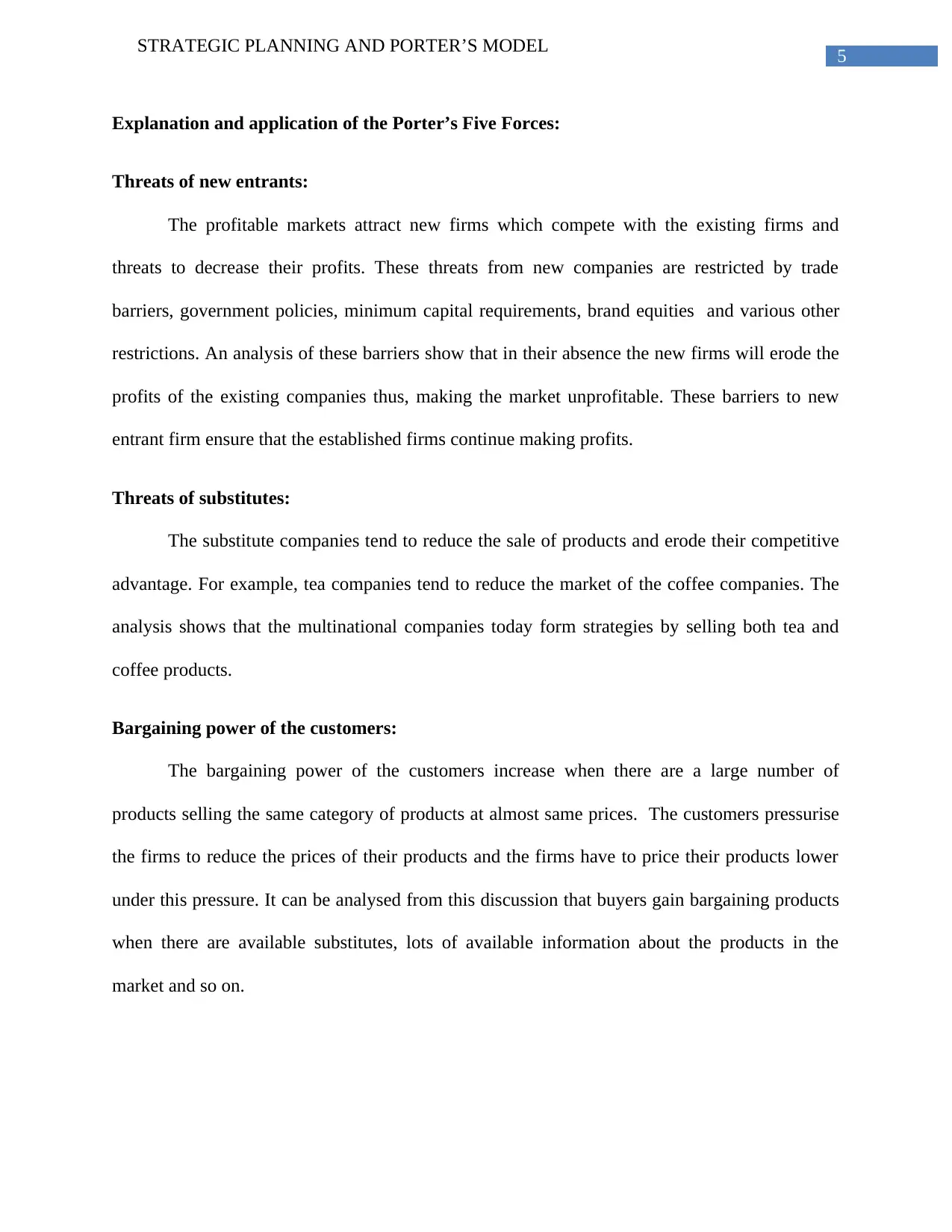Business Strategy: Porter's Five Forces and Generic Strategies
VerifiedAdded on 2020/03/04
|7
|1280
|973
Report
AI Summary
This report provides a detailed overview of Porter's Five Forces model, a framework used to analyze the competitive environment of an industry. It defines the five forces: threats of new entrants, threats of substitutes, bargaining power of customers, bargaining power of suppliers, and industry rivalry. The report explores Porter's Generic Strategy model, including cost leadership, differentiation, and focus strategies, and explains how companies can gain a competitive advantage. It analyzes the advantages and disadvantages of Porter's Model and its application in different business scenarios. The report emphasizes the importance of understanding these forces to develop effective business strategies, navigate market challenges, and achieve sustainable success. Furthermore, the report examines how the forces impact a company's ability to generate profits in a competitive international market. The report also includes a figure illustrating Porter's Five Forces Model for easy understanding.

Running head: STRATEGIC PLANNING AND PORTER’S MODEL
Paraphrase This Document
Need a fresh take? Get an instant paraphrase of this document with our AI Paraphraser

1
STRATEGIC PLANNING AND PORTER’S MODEL
Answer 1:
Definition of five forces:
Porter’s Five Forces model can be defined as a framework which analyses the complex
external factors organisations face from external environment which necessitate them to form
successful strategies to sustain in the international market. The Porter’s Model considers five
micro economic elements which impact the power of the companies to profit in the international
competitive environment. These five forces are defined as under:
Threats of new entrants:
The threats of new entrants can be defined as the threats existing companies functioning
in an industries face from the newly emerging firms. These threats from new entrants are often
checked by limitations or incumbents like existence of barriers to entry and product
differentiation which prevent them from entering the market.
Threats of substitutes:
Threats of substitutes can be defined as the existence of products from outside an industry
which tends to limit the sale of its products. For example, increase among customers to consume
tea may result in fall of sale of coffee. Here tea though not from the coffee industry can affect the
sale of coffee products.
Bargaining powers of customers:
Bargaining power of customers can be defined as situations when customers have the
power to put the firms under pressure to sell products at lower prices. The buyers’ bargaining
STRATEGIC PLANNING AND PORTER’S MODEL
Answer 1:
Definition of five forces:
Porter’s Five Forces model can be defined as a framework which analyses the complex
external factors organisations face from external environment which necessitate them to form
successful strategies to sustain in the international market. The Porter’s Model considers five
micro economic elements which impact the power of the companies to profit in the international
competitive environment. These five forces are defined as under:
Threats of new entrants:
The threats of new entrants can be defined as the threats existing companies functioning
in an industries face from the newly emerging firms. These threats from new entrants are often
checked by limitations or incumbents like existence of barriers to entry and product
differentiation which prevent them from entering the market.
Threats of substitutes:
Threats of substitutes can be defined as the existence of products from outside an industry
which tends to limit the sale of its products. For example, increase among customers to consume
tea may result in fall of sale of coffee. Here tea though not from the coffee industry can affect the
sale of coffee products.
Bargaining powers of customers:
Bargaining power of customers can be defined as situations when customers have the
power to put the firms under pressure to sell products at lower prices. The buyers’ bargaining

2
STRATEGIC PLANNING AND PORTER’S MODEL
power increases when there are several firms selling almost similar products and availability of
substitute products easily at affordable prices.
Bargaining power of the suppliers:
Bargaining power of the suppliers or market of outputs may be defined as the situations
when the suppliers have the power to increase the prices of the products. The bargaining power
of the suppliers may increase under situations like product differentiation, strong distribution
channel and small number of competing firms and so on
Industry rivalry:
Industry rivalry can be defined as situations when there exist a high degree of
competition among the firms in the market. The factors which lead to industry rivalry are
innovation, sustenance, competition on the online platform and firm concentration.
Exploring strategy model:
Porter’s Generic Strategy model describes how companies gain competitive advantage in
the international market. The model stands on three pillars namely, cost leadership,
differentiation and focus or niche marketing. The focus strategy is further divided into cost focus
and differentiated focus.
Cost focus leadership strategy:
The cost focus strategy model by Porter revolves around achieving cost leadership in the
market by increasing profits and reducing their costs. The companies using this strategy charge
very lower prices for their products and are able to attract large number of consumers. This
generates high revenue due to increase in sales which allow these companies to distribute their
STRATEGIC PLANNING AND PORTER’S MODEL
power increases when there are several firms selling almost similar products and availability of
substitute products easily at affordable prices.
Bargaining power of the suppliers:
Bargaining power of the suppliers or market of outputs may be defined as the situations
when the suppliers have the power to increase the prices of the products. The bargaining power
of the suppliers may increase under situations like product differentiation, strong distribution
channel and small number of competing firms and so on
Industry rivalry:
Industry rivalry can be defined as situations when there exist a high degree of
competition among the firms in the market. The factors which lead to industry rivalry are
innovation, sustenance, competition on the online platform and firm concentration.
Exploring strategy model:
Porter’s Generic Strategy model describes how companies gain competitive advantage in
the international market. The model stands on three pillars namely, cost leadership,
differentiation and focus or niche marketing. The focus strategy is further divided into cost focus
and differentiated focus.
Cost focus leadership strategy:
The cost focus strategy model by Porter revolves around achieving cost leadership in the
market by increasing profits and reducing their costs. The companies using this strategy charge
very lower prices for their products and are able to attract large number of consumers. This
generates high revenue due to increase in sales which allow these companies to distribute their
⊘ This is a preview!⊘
Do you want full access?
Subscribe today to unlock all pages.

Trusted by 1+ million students worldwide

3
STRATEGIC PLANNING AND PORTER’S MODEL
expenditures over this revenue. The companies are able to steal customers from their competitors
by using cost leadership strategy and gain market leadership.
The companies especially the multinational companies who lower the prices of their
products face threats from new smaller companies. These companies use strategies like acquiring
advanced technology to make production process more technology intensive to avail mass
product which results in decrease in cost of production. The next strategy used to gain cost
leadership is use fast logistics chain which makes goods available to customers at low price
which allows the companies to sell products at affordable prices which results in generation of
huge revenue. The third strategy is to invest in low cost labour, material and facilities which
reduce the cost of operations. Thus, cost leadership strategy has three parts, the first is adopting
modern technology to avail mass production, the second is lowering prices to surge sales and
maximise profit and the third is to lower the cost of production.
The differentiation strategy:
The differentiation strategy is applied by multinational companies to make their products
and services different from their competitors. The organisations in order to apply differentiation
strategies use innovations; deliver superior quality products and services and aggressively market
their products highlighting the advantages in those products which differentiate them from their
competitor products. The firms keep on introducing new products and advanced versions of their
existing products as a part of their differential strategies.
The focus strategy:
The companies use focus strategy to further differentiate their products from their
competitors. They adopt niche marketing strategies by introducing more low priced and well
STRATEGIC PLANNING AND PORTER’S MODEL
expenditures over this revenue. The companies are able to steal customers from their competitors
by using cost leadership strategy and gain market leadership.
The companies especially the multinational companies who lower the prices of their
products face threats from new smaller companies. These companies use strategies like acquiring
advanced technology to make production process more technology intensive to avail mass
product which results in decrease in cost of production. The next strategy used to gain cost
leadership is use fast logistics chain which makes goods available to customers at low price
which allows the companies to sell products at affordable prices which results in generation of
huge revenue. The third strategy is to invest in low cost labour, material and facilities which
reduce the cost of operations. Thus, cost leadership strategy has three parts, the first is adopting
modern technology to avail mass production, the second is lowering prices to surge sales and
maximise profit and the third is to lower the cost of production.
The differentiation strategy:
The differentiation strategy is applied by multinational companies to make their products
and services different from their competitors. The organisations in order to apply differentiation
strategies use innovations; deliver superior quality products and services and aggressively market
their products highlighting the advantages in those products which differentiate them from their
competitor products. The firms keep on introducing new products and advanced versions of their
existing products as a part of their differential strategies.
The focus strategy:
The companies use focus strategy to further differentiate their products from their
competitors. They adopt niche marketing strategies by introducing more low priced and well
Paraphrase This Document
Need a fresh take? Get an instant paraphrase of this document with our AI Paraphraser

4
STRATEGIC PLANNING AND PORTER’S MODEL
specified products to serve more specific needs of their customers. This strategy works well for
multinational companies having a huge consumer base seeking to further differentiate their
products from the competitors to earn super normal profits.
The Porter’s five forces model:
Figure 1. Porter's Five Forces Model
(Source: Author)
Bargaining power of
suppliers
Threats of new
entrants
Bargaining power of
buyers
Threats of substitutes
Industry Rivalry
STRATEGIC PLANNING AND PORTER’S MODEL
specified products to serve more specific needs of their customers. This strategy works well for
multinational companies having a huge consumer base seeking to further differentiate their
products from the competitors to earn super normal profits.
The Porter’s five forces model:
Figure 1. Porter's Five Forces Model
(Source: Author)
Bargaining power of
suppliers
Threats of new
entrants
Bargaining power of
buyers
Threats of substitutes
Industry Rivalry

5
STRATEGIC PLANNING AND PORTER’S MODEL
Explanation and application of the Porter’s Five Forces:
Threats of new entrants:
The profitable markets attract new firms which compete with the existing firms and
threats to decrease their profits. These threats from new companies are restricted by trade
barriers, government policies, minimum capital requirements, brand equities and various other
restrictions. An analysis of these barriers show that in their absence the new firms will erode the
profits of the existing companies thus, making the market unprofitable. These barriers to new
entrant firm ensure that the established firms continue making profits.
Threats of substitutes:
The substitute companies tend to reduce the sale of products and erode their competitive
advantage. For example, tea companies tend to reduce the market of the coffee companies. The
analysis shows that the multinational companies today form strategies by selling both tea and
coffee products.
Bargaining power of the customers:
The bargaining power of the customers increase when there are a large number of
products selling the same category of products at almost same prices. The customers pressurise
the firms to reduce the prices of their products and the firms have to price their products lower
under this pressure. It can be analysed from this discussion that buyers gain bargaining products
when there are available substitutes, lots of available information about the products in the
market and so on.
STRATEGIC PLANNING AND PORTER’S MODEL
Explanation and application of the Porter’s Five Forces:
Threats of new entrants:
The profitable markets attract new firms which compete with the existing firms and
threats to decrease their profits. These threats from new companies are restricted by trade
barriers, government policies, minimum capital requirements, brand equities and various other
restrictions. An analysis of these barriers show that in their absence the new firms will erode the
profits of the existing companies thus, making the market unprofitable. These barriers to new
entrant firm ensure that the established firms continue making profits.
Threats of substitutes:
The substitute companies tend to reduce the sale of products and erode their competitive
advantage. For example, tea companies tend to reduce the market of the coffee companies. The
analysis shows that the multinational companies today form strategies by selling both tea and
coffee products.
Bargaining power of the customers:
The bargaining power of the customers increase when there are a large number of
products selling the same category of products at almost same prices. The customers pressurise
the firms to reduce the prices of their products and the firms have to price their products lower
under this pressure. It can be analysed from this discussion that buyers gain bargaining products
when there are available substitutes, lots of available information about the products in the
market and so on.
⊘ This is a preview!⊘
Do you want full access?
Subscribe today to unlock all pages.

Trusted by 1+ million students worldwide

6
STRATEGIC PLANNING AND PORTER’S MODEL
Bargaining power of suppliers:
The suppliers have more bargaining power when there are limited numbers of producers
compared to the consumers. The potential reasons for increase in the bargaining powers of the
suppliers are differentiation of products, strong distribution channels, supplier switching costs
more than the firms and increase in the powers of the suppliers to integrate their business
processes vertically and horizontally.
Industry rivalry:
Industry rivalry is high when there are large number of strong competing firms capable of
competing with aggressive business strategies. The companies attract customers in case of high
industry rivalry using strategies like cost leadership strategies and differentiation strategies. This
analysis shows that firms acquire smaller competitor firms to reduce the industry rivalry and gain
higher competitive advantage in the market.
Advantages and Disadvantages of Porter’s Model:
Advantages of Porter’s Model:
The following are the advantages of Porter’s Model:
1. The first advantage of Porter’s model is
STRATEGIC PLANNING AND PORTER’S MODEL
Bargaining power of suppliers:
The suppliers have more bargaining power when there are limited numbers of producers
compared to the consumers. The potential reasons for increase in the bargaining powers of the
suppliers are differentiation of products, strong distribution channels, supplier switching costs
more than the firms and increase in the powers of the suppliers to integrate their business
processes vertically and horizontally.
Industry rivalry:
Industry rivalry is high when there are large number of strong competing firms capable of
competing with aggressive business strategies. The companies attract customers in case of high
industry rivalry using strategies like cost leadership strategies and differentiation strategies. This
analysis shows that firms acquire smaller competitor firms to reduce the industry rivalry and gain
higher competitive advantage in the market.
Advantages and Disadvantages of Porter’s Model:
Advantages of Porter’s Model:
The following are the advantages of Porter’s Model:
1. The first advantage of Porter’s model is
1 out of 7
Related Documents
Your All-in-One AI-Powered Toolkit for Academic Success.
+13062052269
info@desklib.com
Available 24*7 on WhatsApp / Email
![[object Object]](/_next/static/media/star-bottom.7253800d.svg)
Unlock your academic potential
Copyright © 2020–2025 A2Z Services. All Rights Reserved. Developed and managed by ZUCOL.





